磷脂酰胆碱驱动的木质素细胞样组装用于增强和增韧橡胶材料
IF 9.2
1区 化学
Q1 CHEMISTRY, MULTIDISCIPLINARY
引用次数: 0
摘要
同时提高弹性体的强度和韧性一直是一个巨大的挑战。受自然界发现的细胞状结构的启发,本研究利用磷脂酰胆碱调节木质素的极性,从而使木质素在羟基化聚异戊二烯橡胶中形成自组装的“细胞状结构”,为合成高性能橡胶开发了一种绿色策略。通过二维红外分析和分子模拟,阐明了木质素结构自组装的机制。此外,原子力显微镜力距曲线分析表明,磷脂酰胆碱的存在不仅改变了木质素的自组装结构,而且促进了木质素与橡胶基体之间的界面层的形成,从而增强了它们的相容性。“细胞状结构”和相容性转化使木质素增强羟基化聚异戊二烯橡胶具有优异的机械性能,在没有化学永久交联的情况下,具有26 MPa的显著强度和良好的恢复能力。这种创新的方法为高性能橡胶材料的可持续生产开辟了一条新的绿色途径。本文章由计算机程序翻译,如有差异,请以英文原文为准。

Phosphatidylcholine-driven cell-like assembly of lignin for reinforcing and toughening rubber materials†
Simultaneously enhancing the strength and toughness of elastomers has long been a great challenge. Inspired by the cell-like structures found in nature, this study employs phosphatidylcholine to modulate the polarity of lignin, and thereby lignin forms a self-assembly “cell-like structure” within hydroxylated polyisoprene rubber, developing a green strategy for synthesizing high-performance rubber. The mechanism underlying the self-assembly of lignin structures was elucidated through two-dimensional infrared analysis and molecular simulations. Furthermore, atomic force microscopy force-distance curve analysis revealed that the presence of phosphatidylcholine not only altered the self-assembled structure of lignin but also facilitated the formation of an interfacial layer between lignin and the rubber matrix, thereby enhancing their compatibility. The “cell-like structure” and compatibility transformation enable the formation of lignin-reinforced hydroxylated polyisoprene rubbers with outstanding mechanical properties, achieving a remarkable strength of 26 MPa and great recovery capabilities in the absence of chemical permanent crosslinking. This innovative approach pioneers a novel green pathway for the sustainable production of high-performance rubber materials.
求助全文
通过发布文献求助,成功后即可免费获取论文全文。
去求助
来源期刊

Green Chemistry
化学-化学综合
CiteScore
16.10
自引率
7.10%
发文量
677
审稿时长
1.4 months
期刊介绍:
Green Chemistry is a journal that provides a unique forum for the publication of innovative research on the development of alternative green and sustainable technologies. The scope of Green Chemistry is based on the definition proposed by Anastas and Warner (Green Chemistry: Theory and Practice, P T Anastas and J C Warner, Oxford University Press, Oxford, 1998), which defines green chemistry as the utilisation of a set of principles that reduces or eliminates the use or generation of hazardous substances in the design, manufacture and application of chemical products. Green Chemistry aims to reduce the environmental impact of the chemical enterprise by developing a technology base that is inherently non-toxic to living things and the environment. The journal welcomes submissions on all aspects of research relating to this endeavor and publishes original and significant cutting-edge research that is likely to be of wide general appeal. For a work to be published, it must present a significant advance in green chemistry, including a comparison with existing methods and a demonstration of advantages over those methods.
 求助内容:
求助内容: 应助结果提醒方式:
应助结果提醒方式:


